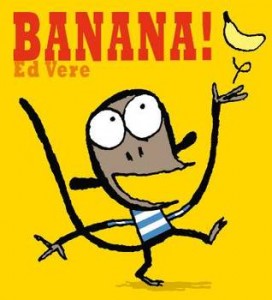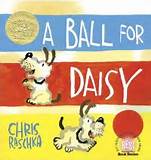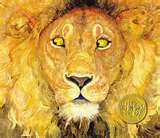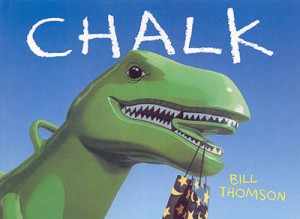Bananas for Early Readers!
 Happy April, everyone! A teacher-friend asked me for super-simple books for readers who are wrestling with her lowest-leveled texts. I shared BANANA! by Ed Vere and the kids went ape. The facial expressions on the two monkeys are so engaging, and the text is limited to two words: “banana” and “please” with either question marks or exclamation points. As I read, I pointed out how the exclamation mark and question mark change the way we read the words. (Print Concepts mini-lesson? Check!)
Happy April, everyone! A teacher-friend asked me for super-simple books for readers who are wrestling with her lowest-leveled texts. I shared BANANA! by Ed Vere and the kids went ape. The facial expressions on the two monkeys are so engaging, and the text is limited to two words: “banana” and “please” with either question marks or exclamation points. As I read, I pointed out how the exclamation mark and question mark change the way we read the words. (Print Concepts mini-lesson? Check!)
Banana! is perfect for readers’ theater. After reading the book to your students, split them into pairs. The kids can make their own monkey masks or hats or puppets. Give students time to practice their lines (nailing that Common Core State Standard of Fluency). Then, kids take turns performing for the class, reading their lines as you hold up the book and turn the pages.
You can make a silly spin-off book called “Apple!” Take photos of two teachers arguing over who gets to eat the apple and lay them out like Ed Vere’s pages. You can make lots of little class books like this if you have a digital camera – let your students be the stars of the book, arguing over and eventually sharing an orange, or a pencil, etc. Your students will go, well, bananas for this book!
I’ll be in Elizabeth, New Jersey this month to talk about the best books to teach preschool and kindergarden reading standards. Next month, I’m the keynote speaker for an early literacy conference in Michigan and I have two presentations to public librarians on Common Core State Standards. Please keep your fingers crossed for ice-storm-free travel days!
Read More
A Ball for Daisy and the Power of Wordless Books
 I am super-geeked that I am a guest blogger for Nerdy Book Club. Nerdy Book Club is a great resource, especially for those readers who are hard to match with just the right book. I like their Top Ten lists, like Top Ten Middle Grade Novels featuring Homeschoolers and Top Ten Books featuring Autism Spectrum Disorders. My list of Top Ten Wordless Picture Books will post on March 30.
I am super-geeked that I am a guest blogger for Nerdy Book Club. Nerdy Book Club is a great resource, especially for those readers who are hard to match with just the right book. I like their Top Ten lists, like Top Ten Middle Grade Novels featuring Homeschoolers and Top Ten Books featuring Autism Spectrum Disorders. My list of Top Ten Wordless Picture Books will post on March 30.
In honor of my Nerdy Book Club debut, I’m sharing with you a wordless book that did not make my Top Ten. It’s the Caldecott winner A Ball for Daisy by Chris Raschka. (Why not in my Top Ten? Check out my post on Nerdy Book Club to see which of my favorites nudged this one out!) Daisy loves her red ball. She loves it so much, she even sleeps with it. One day, she and her owner take the red ball to the park to play. Daisy and her owner are playing fetch when another dog chases – and pops! – the red ball. Daisy is heartbroken. But the next day at the park, the other dog’s owner presents Daisy with a new, blue ball. Now Daisy has a new ball to love, and a new friend.
One element of the Common Core Standard of Key Ideas and Details is “retell stories, including key details, and demonstrate understanding of their central message or lesson”. A Ball for Daisy has such a simple plot that this is easy to do. If you’re working on problem/solution, this book works. If you’re working on first/next/last, this book works. And, if you’re looking for ways to build vocabulary, this book works. (How do wordless books build vocabulary? Read my article on ReaderKidZ.) As you “read” this story to your class, use those rich, expressive words. “Daisy looks distraught over the loss of her ball. She is so sad, she is practically inconsolable.” Your students will develop their listening vocabulary and may even use your Scrabble-worthy adjectives themselves as they retell the story.
A Ball for Daisy would be a great Storybox. Put the book along with two dog puppets and two balls in a Storybox and let students act out their retelling. Your students will have a ball!
Read MoreGot a new device? Play with “Chalk”!
If you were lucky enough to get an iPad, a Kindle, or some other fun e-gizmo this holiday season, and you’d like your kids to use it for more than just throwing (understandably) angry birds, get yourself some Chalk.
Chalk by Bill Thomson is a visually stunning wordless picture book available as a Kindle e-book. (If you have a tablet or an iPad, you can download the Kindle app for free and read Kindle books – cool, huh?) Three children find a bag of chalk on a playground. The things they draw come to life. When one of the children draws a dinosaur, how will the children stop it?
Wordless books like Chalk are a great choice for young readers, and not just because they can “read” the pictures to get the whole story. When children read a wordless book with adults, typically the language the adults use to describe what is happening in the illustrations is of a more complex nature than the sentences and vocabulary usually found in picture books for young ones. (Want to know more? Read my article about wordless picture books for ReaderKidZ.com) So a wordless book can actually work well to teach the Common Core State Standard of Craft & Structure. I love that Chalk offers a great opportunity for problem-solving. When the dinosaur comes to life on the playground in the story, you can ask your young readers, “What would you do?” Kids can brainstorm how they’d solve the problem and discuss Thomson’s solution – the child who drew the dinosaur draws a rain cloud, which becomes real and washes all the chalk (including the dinosaur) away. Talk through the problem and the solution, the beginning-middle-end, and you’re hitting Key Ideas and Details as well!
After you’ve enjoyed Chalk on your device, pair up students and have them sit back to back. If you have a classroom set of iPads, you can use a free drawing app like My Blackboard, or you can go old-school and use real chalk and construction paper, dry erase markers and white boards, etc. Have each student draw something that, if it came to life, would cause a huge problem. Then, students swap pictures and draw something that can then solve that problem.
So, tech it up with your students with the Kindle book and a fun, free app, or embrace the paper and get the book from your local library, but either way, don’t miss out on Chalk!
For more information, please visit billthomson.com.
Read More
Why Wordless Books Work: The Lion and the Mouse
 If we’re trying to help our kids learn to read, why read wordless picture books? Isn’t reading all about letters and words?
If we’re trying to help our kids learn to read, why read wordless picture books? Isn’t reading all about letters and words?
Yes and no.
Reading is: to inspect and apprehend the meaning of writing or other signs or characters. (Thanks, dictionary.com based on the Random House dictionary!) So, reading a book means gaining meaning from the words and from the pictures. Here are some key reading skills kids build when they read wordless books:
- Comprehension as they follow the story shown in the pictures
- Print concepts (we read top to bottom, left to right)
- Sequencing
- Inferring
- Predicting
- Vocabulary
How can a wordless book build a child’s vocabulary? Research led by professors Sandra Gilliam, Ph. D. and Lisa Boyce, Ph. D. from the Emma Eccles Jones College of Education and Human Services at Utah State University showed that mothers used more complex language when sharing a wordless book with their children than they did when they made comments while reading a book with words. (Utah State University Study Shows Parents Are More Engaged With Their Children When Reading Books Without Text June 07, 2011, www.Businesswire.com retrieved June 15, 2012)
And of course, the most important reason to share wordless books is because these books draw kids into a world where even those who struggle with letter recognition can successfully read a fantastic story.
The Lion and the Mouse by Jerry Pinkney is a gorgeous “retelling” one of Aesop’s fables. It won the Caldecott medal, with good reason. Young ones will enjoy the art, and older ones can discuss the deeper layers of the fable.
Before reading The Lion and the Mouse, talk about reading a book with no words. We readers have to really examine the art to understand what is going on. Share this book and let your students either turn to a partner to share or tell the whole group what is happening in the story. Ask students to predict what will happen when they see the hunters setting up the trap and then the lion’s foot stepping on a rope. Use rich vocabulary yourself as you add to the conversation about the plot and what will happen next.
As a writing activity, students can write the dialogue between the lion and the mouse on sticky notes and put them on appropriate pages to read aloud to a friend. It’s perfect for retelling if you make a storybox with a stuffed lion and mouse, and a length of string. No matter what the reading level of your students, all of them will enjoy successfully reading The Lion and the Mouse.
Read More







